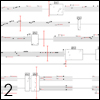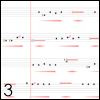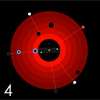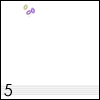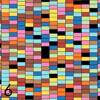Study no. 1 is not necessarily the first animated score I made, but it is the first one I named, documented, and published. Unlike many of my other scores that engage with the rhythmic possibilities of animated notation, Study no. 1 focuses on sustained tones to create a subtley shifting sonority over some time.
Performance Instructions
For 8 or more players.
Begin by arranging the ensemble in a circle facing inward, equidistant from one another. Ideally, the score would be projected on the floor. If this is not possible, the score may be distributed across several screens in the center of the circle. If that is not possible, the score can be projected on one large screen for the players and audience. In this case, all players will have to face the same direction, which may cause difficulties with certain performance aspects.
In performance, each player visualizes a line from their position on the outside of the circle to the center of the circle. The pitch node closest to this virtual line should be played continuously in any register with any playing technique. As the score rotates, and subsequent pitch nodes move into each players' active zone, the current pitch should be replaced by the new one.
Dynamics are determined by the active pitch node's distance from center. Dynamics should range from ppp (furthest from center) to MF (closest to center).
When a red circle appears on a player's respective pitch node, that player should immediately begin playing each subsequent pitch node, moving clockwise. The distance between subsequent pitch-nodes determines relative duration, although all notes should be relatively short. Dynamics should be kept to a minimum while playing a pitch-node melody. The player should make one full rotation before the red circle has faded out.
When a red line appears between two players' respective pitch nodes, each player should detune their current pitch toward the other player's pitch. Based on instrument restrictions it may not be possible to smoothly tune up or down far enough. This is OK. There may be confusion as to which player one should be tuning toward. This is also OK.
When the outer circle turns red, all players should quickly tune up approx. 1/4 step, and tune back down when the circle has returned to black. When the inner circle turns red, all players should quickly tune down approx. 1/4 step, and tune back up when the circle has returned to black.
Duration: 15 minutes or more.
Ryan Ross Smith, September 2010.
If you would like a copy of this animated score for performance, or have any questions about the animated notation used in this piece, feel free to get in touch! My contact information can be found here.
